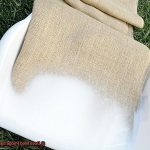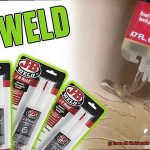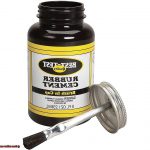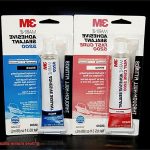Are you tired of getting stuck when trying to stick plastic together?
Well, guess what? Marine silicone might just be the superhero you’ve been waiting for.
![]()
Whether you’re a DIY pro or a marine industry expert, knowing which materials work best together is key to nailing your projects. And that brings us to the burning question: Does marine silicone stick to plastic?
In this blog post, we’ll take a deep dive into the world of marine silicone adhesive and its magical powers on plastic surfaces. Get ready to unravel the secrets behind creating rock-solid and waterproof connections.
So, let’s set sail into the amazing realm of marine silicone and discover how it can revolutionize your plastic bonding adventures.
What is Marine Silicone?
Contents
- 1 What is Marine Silicone?
- 2 Adhesion Properties of Marine Silicone
- 3 Plastic Compatibility with Marine Silicone
- 4 Polyethylene and Polypropylene Plastics
- 5 PVC, ABS, and Polycarbonate Plastics
- 6 Surface Preparation for Optimal Adhesion
- 7 Application Techniques for Applying Marine Silicone to Plastic Surfaces
- 8 Alternative Adhesives for Bonding Plastic Surfaces
- 9 Conclusion
In the world of marine applications, finding an adhesive that can effectively bond and seal plastic surfaces can be quite the challenge. However, fear not, for marine silicone emerges as the hero in this scenario.
Specially formulated to withstand the harshest conditions of saltwater, extreme temperatures, and constant exposure to moisture, marine silicone offers exceptional adhesion properties and durability.
Here, we will delve into the properties and uses of marine silicone, shedding light on its compatibility with different types of plastics.
Properties of Marine Silicone:
Marine silicone is a combination of silicone polymers and additives that enhance its performance in marine environments. Its ability to adhere to various materials, including plastic, sets it apart from other adhesives. Additionally, marine silicone boasts excellent resistance to UV radiation, ozone, and saltwater corrosion.
Compatibility with Plastics:
While marine silicone generally provides good adhesion to plastic surfaces, it is essential to consider certain factors that may affect its compatibility. Plastics with low surface energy or chemical resistance, such as polyethylene and polypropylene, can pose challenges for any adhesive. In such cases, specialized primers or surface treatments may be necessary to improve adhesion.
Application Process:
To achieve optimal bonding strength between marine silicone and plastic surfaces, thorough surface preparation is crucial. Begin by cleaning the plastic surface with a suitable solvent or cleaner to remove any dirt, grease, or debris that could hinder adhesion.
Once the surface is clean, apply the marine silicone using a caulking gun or an appropriate applicator. Follow the manufacturer’s instructions regarding application temperature and curing time for the best results.
Alternative Options:
In instances where marine silicone does not provide sufficient adhesion to a particular plastic substrate, alternative adhesive solutions may be considered. Specialized plastic adhesives or epoxy adhesives can be viable options. Mechanical fastening methods, such as screws or bolts, are also effective alternatives.
Adhesion Properties of Marine Silicone
Today, we embark on an exciting journey to delve into the adhesion properties of marine silicone when it encounters plastic surfaces. With my expertise and extensive research in tow, I’ll guide you through this captivating topic. So, buckle up your life jackets and let’s dive right in.
Surface Preparation: Setting the Stage for Success
Before our marine silicone can work its magic, we must ensure that our plastic surfaces are primed for the bonding voyage. With meticulous attention to detail, we cleanse our plastics using a suitable agent, banishing any pesky contaminants or oily residues that might hinder adhesion. And fear not if our plastics need a bit of roughing up – a gentle sanding will provide the perfect texture for maximum bonding.
The Art of Compatibility:
Just like finding the perfect shipmate, compatibility between marine silicone and the plastic material is paramount for a robust bond. Not all plastics are created equal, my friends. Some possess high chemical resistance or low surface energy, posing challenges to adhesion. To navigate this obstacle-ridden sea, we consult the manufacturer’s guidelines or conduct a small test patch to ensure seamless compatibility between our marine silicone and the specific plastic material.
Conquering the Low Surface Energy Trio: Polyethylene, Polypropylene, and Primers
Brace yourselves for the formidable low surface energy trio – polyethylene (PE), polypropylene (PP), and their relentless resistance against adhesives. These plastics are notorious for their reluctance to bond with even our beloved marine silicone.
In our arsenal, we wield specialized primers that act as secret weapons to enhance adhesion between these tricky plastics and marine silicone. With these primers at our side, we can conquer any bonding battle with unwavering confidence.
![]()
Smooth Sailing with Common Plastics:
Now that we’ve navigated through treacherous waters, let us revel in the triumph of bonding marine silicone with common plastics used in boat construction and repairs. ABS, PVC, polycarbonate – these plastics are our steadfast comrades. With their higher surface energy and welcoming nature, they wholeheartedly embrace our marine silicone adhesive. With these plastics, we can achieve a bond that defies the test of time and turbulent seas.
![]()
Setting Sail with Caution:
As we near the end of our adhesive adventure, I must remind you to proceed with caution. While marine silicone offers excellent adhesion to plastic surfaces, not all applications may be suitable. Consider factors such as stress, movement, extreme temperatures, and exposure to chemicals. In demanding situations like these, it may be prudent to explore alternative adhesives that better align with your needs.
Plastic Compatibility with Marine Silicone
When it comes to the compatibility of plastic with marine silicone, not all plastics are created equal. Just like the diverse crew on a ship, different plastics have unique characteristics that can affect their bond with marine silicone. Understanding the compatibility of various plastics is essential for successful adhesive endeavors.
Some plastics, such as polyethylene (PE), polypropylene (PP), polyvinyl chloride (PVC), acrylonitrile butadiene styrene (ABS), and polycarbonate (PC), are known to be great companions for marine silicone. These plastics bond effortlessly, forming a strong and durable connection that withstands the test of time.
However, there are a few plastics that may not be as keen on partnering up with marine silicone. Low surface energy plastics like polytetrafluoroethylene (PTFE) and high-density polyethylene (HDPE) have a bit of a standoffish nature when it comes to adhesion. Their low surface energy makes it more challenging for the silicone to effectively stick to them.
To ensure a successful bond, proper preparation of the plastic surface is crucial. Just like scrubbing the deck before a grand celebration, make sure the surface is clean, dry, and free from any grime or residues. A pristine surface sets the stage for an excellent adhesive performance.
In addition to surface preparation, using primers or adhesion promoters specifically designed for plastics can enhance the bond even further. These magical potions work their charm by improving the strength and durability of the silicone bond on plastic surfaces.
When using marine silicone on plastic, consider environmental challenges such as exposure to water, UV radiation, temperature fluctuations, and mechanical stress. These elements can put the strength of your bond to the test. Choose the right adhesive for the job and be prepared.
While marine silicone is generally compatible with many plastics, it’s always wise to test a small area first or consult the manufacturer’s recommendations for specific plastic compatibility information. This way, you can ensure a strong and durable bond that will withstand the test of time – just like a loyal shipmate.
Polyethylene and Polypropylene Plastics
Bonding marine silicone to polyethylene and polypropylene plastics presents unique challenges due to their low surface energy. These plastics are commonly used in marine applications for their chemical resistance and durability. However, their low surface energy makes it difficult for adhesives to form strong bonds. In this article, we will explore the specific sub-topics, provide examples, and discuss the solutions to overcome these challenges.
Low surface energy of polyethylene
- Polyethylene’s low surface energy poses a challenge for adhesive bonding.
- Adhesives struggle to create strong bonds due to the lack of molecular interaction.
- Surface preparation techniques such as flame treatment or chemical etching can increase the surface energy, enabling better adhesion.
Low surface energy of polypropylene
- Polypropylene shares a similar challenge with its low surface energy.
- Chemical treatments using primers or adhesion promoters can enhance bonding properties with marine silicone.
Selection of suitable silicone adhesives
- Not all silicone adhesives are compatible with polyethylene and polypropylene.
- Specialized marine-grade silicones are formulated with additives and modifiers to enhance adhesion properties to low surface energy plastics.
- It is crucial to choose the right silicone adhesive specifically designed for bonding with these plastics.
Example 1: Bonding marine silicone to a polyethylene boat hull
- Flame treatment or chemical etching prepares the boat hull’s surface.
- Increased surface energy allows for better adhesion.
- Select a marine-grade silicone adhesive suitable for bonding with polyethylene.
Example 2: Bonding marine silicone to a polypropylene pipe
- Treat the polypropylene pipe’s surface with a primer or adhesion promoter.
- Enhanced bonding properties between plastic and silicone adhesive.
- Choose a marine-grade silicone adhesive compatible with polypropylene.
PVC, ABS, and Polycarbonate Plastics
A comprehensive understanding of the unique properties and characteristics of PVC, ABS, and Polycarbonate plastics is essential when it comes to selecting the right material for a particular application. In this guide, we will explore the differences between these three commonly used plastics and how they can impact their compatibility with various adhesives. By delving into their individual strengths and weaknesses, we can gain valuable insights into their suitability for different industries and applications.
PVC (Polyvinyl Chloride):
- Renowned for its durability, flexibility, and resistance to chemicals.
- Provides a smooth surface that facilitates excellent adhesion with marine silicone adhesive.
- Widely used in construction applications such as pipes, fittings, and vinyl siding due to its outstanding performance.
ABS (Acrylonitrile Butadiene Styrene):
- Recognized for its exceptional strength and impact resistance.
- Can present a somewhat porous surface, making it more challenging to bond with adhesives.
- Preparing the ABS surface through thorough cleaning and the use of a primer or adhesion promoter designed specifically for ABS can enhance the bonding process.
![]()
Polycarbonate:
- Transparent and highly impact-resistant plastic that offers exceptional clarity.
- Generally compatible with marine silicone adhesive due to its smooth surface.
- Some types may contain additives or coatings that can affect adhesion properties, necessitating verification of compatibility between specific polycarbonate types and marine silicone adhesive.
While PVC and polycarbonate plastics typically offer good compatibility with marine silicone adhesive, bonding ABS plastic may require additional preparation steps.
Ensuring a strong bond involves meticulous cleaning, adequate priming, and conducting small-scale tests to verify compatibility.
With proper surface preparation techniques and the selection of appropriate adhesives tailored to each plastic type, successful adhesion in marine environments is achievable.
![]()
Surface Preparation for Optimal Adhesion
![]()
Unlocking the power of marine silicone glue to bond plastic surfaces requires more than just slapping it on and hoping for the best. The key to optimal adhesion lies in meticulous surface preparation. In this article, we’ll delve into the step-by-step process of prepping plastic surfaces to ensure a bond that stands the test of time.
Step 1: Purge the Impurities
The first step toward achieving the perfect bond is clearing away any surface debris. Gently wipe the plastic surface with a clean cloth or sponge dampened with mild soap and water. This preliminary cleaning eliminates dirt and grime, laying the foundation for further purification.
Step 2: Banish Stubborn Contaminants
For those pesky grease or oil stains, don’t fret. Arm yourself with a mild solvent or degreaser specifically formulated for plastics. Test it discreetly on a small area to ensure compatibility, then apply it to obliterate stubborn contaminants. Follow the manufacturer’s instructions diligently to avoid any mishaps.
Step 3: Rinse Away Residual Worries
Once you’ve waged war against contaminants, it’s time for a thorough rinse. Flush the surface with clean water, ensuring every nook and cranny is free from residue left by cleaning agents. Remember, a squeaky-clean surface is crucial for optimal adhesion.
Step 4: Embrace Imperfections
To create a bond that can withstand the harshest conditions, roughening the plastic surface might be necessary. Embrace your inner artisan and gently sand the surface using fine-grit sandpaper. These delicate abrasions provide additional surface area for the silicone glue to grip onto, enhancing adhesion like never before. Ensure you remove any resulting dust by wiping or blowing it away.
Step 5: Prime for Perfection
Certain plastics demand special treatment to achieve adhesion nirvana. If your plastic sports a smooth or glossy exterior, consider applying a primer designed to promote adhesion on plastics. Follow the primer manufacturer’s instructions meticulously and allow sufficient drying time before proceeding to the grand finale.
Step 6: Atmosphere Matters
![]()
Remember, the environment plays a vital role in adhesion success. Ensure the surface preparation and silicone application take place within the recommended temperature and humidity range. Extreme temperatures or high humidity can throw a wrench in the adhesion and curing process, leaving you with lackluster results.
Application Techniques for Applying Marine Silicone to Plastic Surfaces
In this section, we will explore the art of applying marine silicone to plastic surfaces, uncovering the secrets to achieving a strong and long-lasting bond. So grab your caulking gun and let’s dive in.
First, preparation is key. Before applying marine silicone to plastic surfaces, it’s crucial to ensure that the surfaces are squeaky clean. Wave goodbye to dirt, grease, and other pesky contaminants by giving the surfaces a thorough wipe-down with a suitable cleaner or solvent. This creates the perfect foundation for your adhesive masterpiece.
But wait, there’s more. To truly elevate your bonding game, consider using a primer specifically designed for plastic surfaces. This little hero enhances the adhesion of marine silicone to plastic, ensuring a bond that will withstand even the roughest seas. So don’t skip this step – prime it up.
Now, let’s talk about the application itself. Like a skilled artist with a paintbrush, apply the marine silicone with precision and finesse. Load up your trusty caulking gun and follow the manufacturer’s instructions for bead size and application technique. Too much silicone can lead to a messy application, while too little may result in a weak bond. Find that sweet spot and squeeze away.
But don’t stop there. Once you’ve applied the marine silicone, it’s time to smooth things out. Grab a tool or dip your finger in a mild soap solution and gently shape and smooth the bead. This step not only ensures a neat and professional finish but also helps improve the overall strength of the bond.
Now, here’s where patience comes into play. Allow sufficient curing time for the marine silicone before subjecting the bonded plastic surfaces to any stress or load. The curing time can vary depending on factors like temperature and humidity, so be sure to consult the manufacturer’s guidelines for specific recommendations. Remember, good things come to those who wait.
![]()
In some cases, a little extra support may be needed to ensure a flawless bond. Tape, clamps, or other appropriate methods recommended by the manufacturer can provide that extra boost. So don’t be afraid to get creative with your support system.
Last but certainly not least, regular inspection is crucial to ensure that your bond remains shipshape. Keep an eye out for any signs of failure or deterioration and address them promptly. After all, prevention is better than a sinking ship.
Alternative Adhesives for Bonding Plastic Surfaces
Marine silicone may be the go-to choice for bonding plastic surfaces, but there exists a wealth of alternative adhesives that offer unique advantages and disadvantages. In this comprehensive guide, we will explore the world of alternative adhesives for bonding plastic surfaces, uncovering their distinctive qualities and suitability for various applications.
Epoxy Adhesives:
Epoxy adhesives are renowned for their exceptional bonding capabilities and find extensive use in industrial applications. Notably, they can bond a wide range of plastics, including ABS, PVC, and polycarbonate. However, it’s important to note that epoxy adhesives require the meticulous mixing of two parts and have a curing time before reaching maximum strength.
Cyanoacrylate Adhesives (Super Glue):
For those seeking swift and robust bonds on plastics like acrylic, polystyrene, and polyethylene, cyanoacrylate adhesives are the perfect solution. These adhesives cure rapidly, displaying resistance to moisture and temperature fluctuations. However, they may not be suitable for bonding certain low surface energy plastics.
Polyurethane Adhesives:
Polyurethane adhesives offer excellent flexibility and durability, making them ideal for bonding challenging plastics such as polypropylene and polyethylene. Nevertheless, it should be noted that these adhesives require moisture to cure and achieve optimal strength.
![]()
Solvent-Based Adhesives:
If you’re working with specific plastics like polyvinyl chloride (PVC), solvent-based adhesives can prove highly effective. These adhesives function by dissolving the plastic surface, facilitating fusion as the solvent evaporates. However, it’s important to take precautions as solvent-based adhesives emit potent fumes and should be utilized in well-ventilated areas.
Specialty Adhesives:
When it comes to specialized applications like glass bonding or clear plastic assemblies, acrylic-based adhesives reign supreme. These adhesives boast outstanding clarity and UV resistance, but they may have limited applications and could be costlier compared to other alternatives.
G-aQzoHqM80″ >
Conclusion
In conclusion, it is evident that marine silicone does indeed stick to plastic.
This adhesive has proven its reliability and strength in numerous marine applications, making it an ideal choice for bonding plastic materials. Whether you’re repairing a boat or constructing an underwater structure, marine silicone offers a secure and long-lasting bond that withstands the harsh conditions of the sea.
So, if you’re looking for a dependable adhesive solution for your plastic projects in marine environments, look no further than marine silicone.





